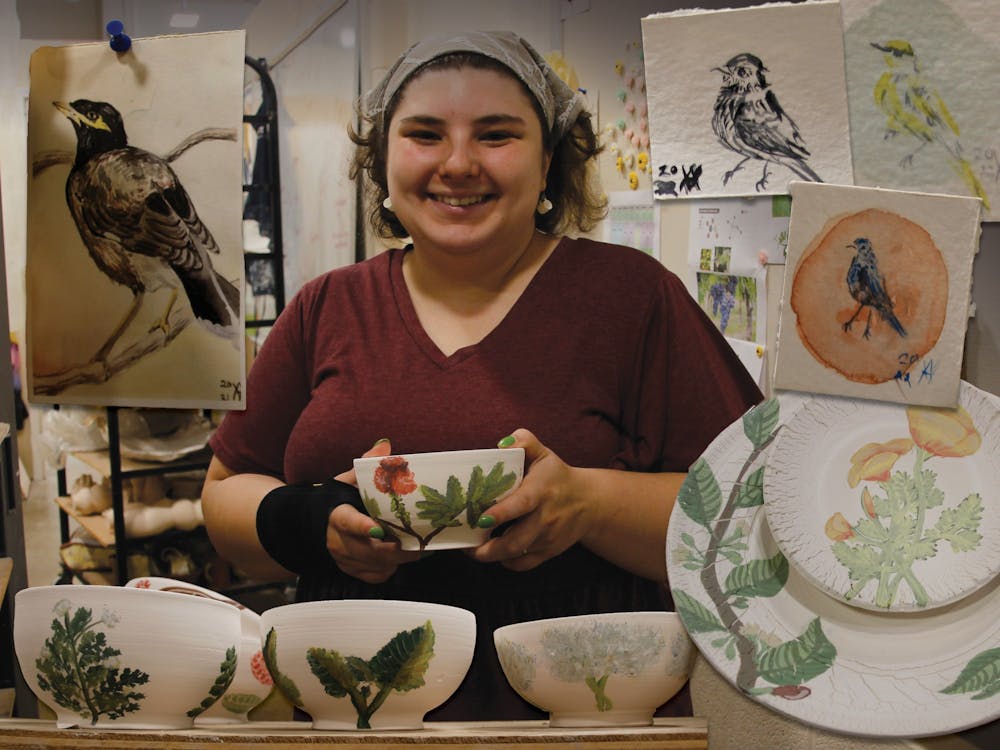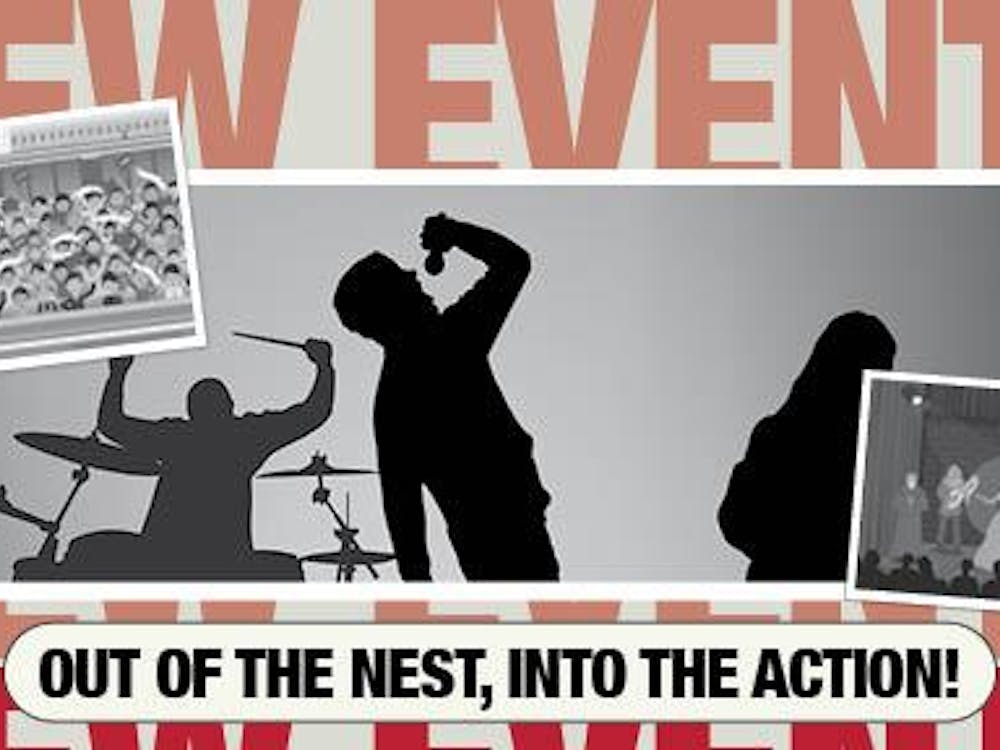Little Bird
Ceramics graduate student Mary Vozenilek didn’t expect her professor to eat his own work.
The week before April Fools’ Day, during her undergraduate at Southern University Illinois Edwardsville, Teacher’s Assistant Cody Thompson demonstrated shaping a bowl on a pottery wheel, then took a bite of his completed work. Vozenilek said she couldn’t believe it.
“Porcelain is a little Velveeta-cheese-ish,” she said.
Though it looked like porcelain to Vozenilek and her classmates, the TA used cream cheese to show how similar the textures were.
This wasn’t the first time Vozenilek had to decipher between food and clay.
The Peoria, Illinois, native enjoys making things that are functional. She started ceramics at age 15, now 25, and decided early on that she wanted to either be an artist or a cook. But since she said she is easily stressed in fast-paced work environments, she decided to pursue art.
Vozenilek started off working at a glassblowing studio in Peoria and ended up getting a minor for it in her undergraduate degree at Ball State. She even taught a few classes while working at the studio and is looking forward to teaching in the future.
Though she enjoyed glassblowing, she missed ceramics and decided to rent a space in a warehouse for artists to pursue her work.
Vozenilek started selling pieces at farmer’s markets, but she struggled to keep up with the demand for things like mugs and vases, so she had to stick to simple textures and landscapes.
The weekend art markets happened in the summer, which was “super convenient because that’s when you don’t blow glass a lot because the room temperature in a glassblowing studio goes up about 20-30 degrees,” she said.
The pieces Vozenilek made to sell versus what she created for enjoyment were different in nature. The projects she develops on her own time are more artistic and thematic than what she sells.
Currently, she is working with the theme of generational trauma by using the theme of poisonous plants on her pieces.
“You take something that might be a good thing and then it ends up sort of slowly poisoning you, or you take something that is a poison and just small enough doses that can actually be used for [medicine],” she said. “So that's why a lot of these plants are actually … used medicinally, but in higher doses can be very bad for you, or this is a plant that is actually really common.”
When Vozenilek’s parents got a divorce, ceramics helped her deal with the difficult time. She started using fungus-based pieces with lots of texture showing elements of decomposition.
“I was thinking about how the relationship had died, but things were getting better in a roundabout way,” she said. “It was sort of [the] death of something old and turning into something new without it being like a zombie.”
She said she felt like she could not sell these pieces in a farmer’s market setting because the prices were higher due to the time and skill involved with each individual item.
Vozenilek said ceramics is a communal form of art and exists because people needed objects to put food on that wouldn’t dissolve. She is now working on a dinnerware set centered around her Italian family and the importance of eating at the dinner table together.
“That's sort of where the family can … come to dinner every night,” she said. “My wife didn't have that.”
The name of Vozenilek’s online shop Little Bird Pottery was based on the nickname her wife calls her: little bird. Most of her work on the site includes birds, mainly cardinals.
“There’s a common myth to imagine that a loved one is being reincarnated as a cardinal,” she said. “So if somebody’s passed away and you see a cardinal, that’s grandma visiting.”
Pursuing Education
Ball State second-year Hannah Cushner became interested in ceramics when she joined an after-school art club in fourth grade.
“I went to Catholic schools my whole life, so the art programs are always a little bit iffy, but my mom would make sure to get me into certain classes at the Indianapolis Art Center,” Cushner said.
During her time in the club, Cushner said she took a variety of classes including ceramics, glass and metals and took classes through her eighth grade year.
Cushner’s art teacher helped her discover her passion for ceramics.
“One of the reasons I’m going into art education is because of her,” she said. “She would always push me to try new things and just explore … because ceramics was all new for her too.”
Cushner took architecture courses in high school, which led her to choose that for her major.
She said she loved the hand drafting and designing aspect of this program and decided to pursue architecture after receiving second place nationally in the National Association of Women in Construction contest.
She said she felt there was a big push from her high school to continue her education in architecture. Once she started classes at Ball State, she discovered it wasn’t the right fit for her.
“I learned that architecture is not all about hand drafting, and it wasn’t necessarily worth it because it didn’t fit with my other ideals for my life that I wanted,” Cushner said. “I would love to have a big family. I’d love to travel, and architecture is very much work is life.”
Cushner originally enjoyed being in the architecture program until she had to “pull an all-nighter” and became sick for a month, she said.
“I was like, ‘Okay, this is a sign from God here. I need to change what I’m doing,’” Cushner said. “So I took a really deep look into what I wanted and that kind of led me to art education.”
Now an art education major, Cushner said she spends about four or five days each week in the ceramics studio.
“This is my safe place; this is my home,” she said. “I love it here.”
In the studio, Cushner spends time on personal and class projects. For her, clay is a calming medium. She said it can be frustrating sometimes, but it can form many things as well. She said it provides income through selling and you can incorporate other materials into it, like metal and glass.
Faith plays a large role in Cushner’s life, so much of her inspiration for her art comes from religion, she said.
“I feel like I tend to lean towards beauty and creation and family,” Cushner said. “One of my pots I did on feminine beauty. I had the heart that is created turn into the female, which was made to be beautiful.”
As part of the art education program, students assist with Saturday art classes run by Ball State. In one of the classes, Cushner helped first and second graders stay on task with learning about complementary colors, she said, and giving overall words encouragement.
In the future, she said she would enjoy teaching at a Catholic school, though she is worried because Catholic schools don’t always get funding for their art programs.
“It would be wonderful to be in a school surrounded by my faith and being able to express that freely,” Cushner said.
Sculpting Growth
Coming from an artist and an electrician as parents, Ted Neal grew up to be a ceramic artist.
“Being raised in a family of people that worked with their hands, I learned a lot of skills early on, and it's run the gamut,” Neal said.
Prior to being a ceramics professor at Ball State, he has worked with carpenters, painters, plumbers, electricians, framers, masons, etc. He used all of this experience and became a self-employed contractor.
Neal ran his business for six years while being in school and paid for it as well.
“All of [those] mesh together to what I do now, which is not only teach, but I'm able to go and use those skills to build our facility here and to go other places and help them with their facility,” Neal said.
He said real world experience is the most important thing in his classroom. He takes his students on trips to museums, brings in visual artists and helps them build equipment, so they can get the experience they need and establish their community.
“You can’t be an artist and a hermit and expect to have success,” Neal said. “You're a part of a community in general that are going to be your customers … and you have to establish a presence in both of those areas to be successful.”
Neal has been working in ceramics for 30 years. Being an artist is not always the easiest road, but it is rewarding at the same time, he said.
Along with blue-collar work, Neal has experience in drawing and designing, among other types of art.
According to Neal’s course schedule, he is currently teaching seven classes. One class has students sculpt a live model.
“I'm sort of fascinated to have that be part of my program because it's not typical,” Neal said. “It's a reach for me, even though I have some experience, and I thought it would be really good.”
He said after working for so long with the same materials, they become familiar, and he is able to make what his mind sees. A big challenge as someone with an advanced skill set like him is keeping his work fresh and learning new things.
“The growth as a creative only happens when you allow for flexibility and re-evaluation of work and then changing direction and then growing,” Neal said.
Alongside teaching at Ball State, Neal also travels to other places and teaches how to build kilns including train wood kilns, soda kilns, salt kilns, centenary wood kilns, pizza ovens and more. Recently, Neal traveled to Pennsylvania to teach this workshop.
“I love that aspect of what I do because [of] the same reason I liked having community members in here,” Neal said. “I get to go out, represent Ball State, I get to leave behind a thing, a piece of equipment that will continue to function as a support structure for that group of people for years.”
Being an artist is hard because you can spend a lifetime doing one style of art and never run out of things to do, Neal said. He wants to learn and create more because “to say that you’ve sort of done it all is impossible.”
Neal said there is only so much time in your lifetime to explore.
Recently, he has been focusing primarily on using stoneware clay, which gives his products a metallic look. Neal concentrates on consumerism in his work, and he infuses his thoughts about consumer culture into objects.
“When I came here 17 years ago, I was kind of in awe of how awesome this building was and how much space we had,” Neal said, “and I feel like I've been supported in all of the goals that I've had in building this up.”
Each of these people are involved on campus. Cushner is the promotions officer for the Art Ed Club and is a member of the Clay Guild. She helps plan Art Ed Club events and takes care of the emails and Instagram page, she said. Vozenilek is the vice president of the Clay Guild on campus and helps plan future events for the program. Although he is not involved in any clubs, Neal supports the art program by making and building plenty of the materials used in the ceramics studio, he said.
These people have given and continue to give back to Ball State and the community through their passions.
Contact Lila Fierek with comments at lkfierek@bsu.edu or on Twitter @fierek_lila.
Contact Josie Santiago with comments at josephine.santiago@bsu.edu.





